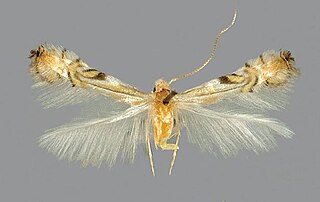
Phyllonorycter is a genus of moths in the family Gracillariidae.

Telamoptilia is a genus of moths in the family Gracillariidae.

Epicephala is a genus of moths in the family Gracillariidae.

Caloptilia is a genus of moths in the family Gracillariidae.

Phyllocnistis is a genus of moths in the family Gracillariidae.

Aristaea is a genus of moths in the family Gracillariidae.
Conopomorpha is a genus of moths in the family Gracillariidae.
Cuphodes is a genus of moths in the family Gracillariidae.

Phrixosceles is a genus of moths in the family Gracillariidae.
Spulerina is a genus of moths in the family Gracillariidae.

Stomphastis is a genus of moths in the family Gracillariidae.

Parectopa is a genus of moths in the family Gracillariidae.

Dialectica is a genus of moths in the family Gracillariidae.

Macarostola is a genus of moths in the family Gracillariidae. The genus was erected by Edward Meyrick in 1907.

Marmara is a genus of moths in the family Gracillariidae.
Melanocercops is a genus of moths in the family Gracillariidae.
Callicercops milloti is a moth of the family Gracillariidae. It is known from Madagascar. The larvae feed on Bauhinia species. They roll the leaf of their host plant.
Callicercops triceros is a moth of the family Gracillariidae. It is known from Mauritius, Namibia, Zambia, Zimbabwe and South Africa.
Callicercops iridocrossa is a moth of the family Gracillariidae. It is known from China and Japan. The wingspan is 9.2–11.8 millimetres (0.36–0.46 in). The larvae feed on Bauhinia japonica. They probably mine the leaves of their host plant.

Gracillariinae are a subfamily of moths which was described by Henry Tibbats Stainton in 1854.
This page is based on this
Wikipedia article Text is available under the
CC BY-SA 4.0 license; additional terms may apply.
Images, videos and audio are available under their respective licenses.









